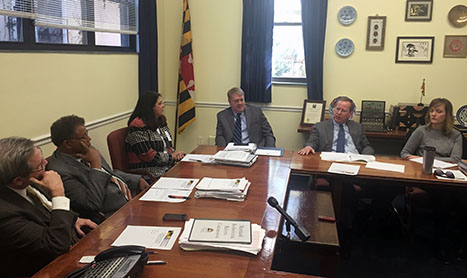
ANNAPOLIS– The Maryland Redistricting Reform Commission voted on Tuesday to recommend the establishment of an independent panel to address congressional and legislative voting districts.
The commission called on the panel to create “congruence,” “contiguity” and “compactness” in the new voting districts, along with upholding equal population and federal voting laws.
Nine of the 11 members of the commission approved the final recommendations. Delegate Alonzo Washington, D-Prince George’s, was the only member of the commission to vote against the official recommendations. Sen. Joan Carter Conway, D-Baltimore City, was not present at the meeting to vote.
Washington called the committee’s work a “good effort,” but said he is skeptical whether the recommendations could “actually get done” in Annapolis. He also said there was not enough time to fully flesh out other possible ideas.
Commission member Christopher Summers, founder and president of the Maryland Public Policy Institute, echoed Washington in wishing for more time.
This process was like “opening the fire hydrant and trying to take a drink from it,” Summers said. With the expanded time, Summers said, he would have liked to have outside experts come in from other states that have successfully redistricted, such as California and Iowa.
If the legislature adopted the commission’s recommendations, Summers said, it would still be a “monumental shift.”
At a news conference on Tuesday, announcing the reopening of the Maryland State Police Annapolis Barrack, Gov. Larry Hogan, R, said that people want to see nonpartisan redistricting.
“There’s a handful of professional politicians who want to keep things the way that they are. We’re the most gerrymandered state in the country. We’re hoping that they’ll listen to some reasoning,” Hogan said. “I’m looking forward to getting the report from the commission, or maybe we’ll be able to talk to the (Senate President) when he realizes I’ll be the guy drawing the districts. He might change his position.”
The commission held five public regional meetings in different parts of Maryland, hearing from legislators and residents about their ideas on how to reform voting districts.
Hogan in August signed an executive order creating the commission to address gerrymandering in both legislative and congressional voting districts.
In Maryland, redistricting occurs every 10 years following the results of the U.S. census. In 2012, Gov. Martin O’Malley, D, redrew the 6th congressional district, taking away conservative votes in order to oust a veteran Republican.
Registered Democrats outweigh registered Republicans in Maryland more than 2-to-1, according to eligible active voter data from the 2014 gubernatorial election.
Seven of the state’s eight seats in the U.S. House of Representatives are held by Democrats.
When redistricting, according to Maryland’s constitution, the governor is required to hold public hearings to create a legislative district plan. The governor’s plan automatically takes effect 45 days into the legislative session unless the General Assembly drafts its own plan.
The Maryland constitution requires 47 legislative districts, with one senator and three delegates from each. It also requires that the districts must have roughly equal population, and be compact and contiguous.
The current “system is corrupt. Its broken.” Summers said. “I still believe we’re in a unique period of time in Maryland history to do something bold.”
(CNS correspondent Brittany Britto contributed to this report.)


You must be logged in to post a comment.